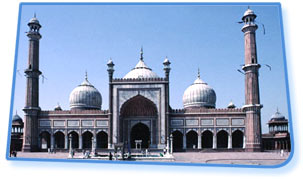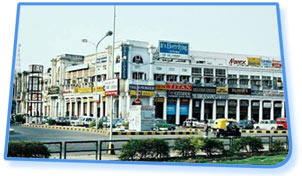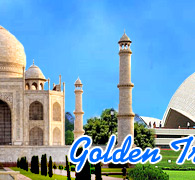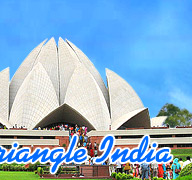Delhi City, Delhi Tour Packages, New Delhi Tours, Golden Triangle Delhi Tours, Delhi Tourism.

Delhi
has always been a seat of power and a witness to the reign of different
dynasties, both Hindus and Muslims and the terrible wars and revolts
that have resulted in overturning of thrones and passing of the city
from one hand to other. It has also been under the British rule for long
and the well planned and sophisticated and aristocratic structures of
the later period can be attributed to that period. These diverse rulers
have left an indelible impression on the rich architectural and cultural
heritage of the city.
The history of Delhi is believed to be 2500 years old. In the 12th
centre, Delhi emerged as the most important centre of Hinduism is north
India during the reign of Chauhans but since 1193, when Qutab-ud-din
Aibak occupied the city, it had been almost constantly under Muslim rule
as Delhi Sultanate that possessed the city from 1206 to 1526 was
followed by the Mughal empire that lasted till 1857. Then, British got
hold of the city and they deprived Delhi of being the political capital
of India despite its being the important commercial centre until 1911,
when they could no longer restrain the spirit of Delhi to once again
achieve the status of being the city of rulers. However, they did give a
new face to the city in the form of the well-planned and imperial New
Delhi. Today, most of the Delhi population consists of those who
migrated here from various places during 'Partition' or afterwards due
to the immense opportunities that the city had to offer.
Shopping Attractions

There
are beautiful shopping complexes and flourishing markets studded with
brightly lit and well-decorated showrooms where you can get all you want
including silk products, precious stones and leather woodwork. Janpath
in Cannaught Place has many stores from where you can buy genuine items
from all over India at reasonable prices. Chandni Chowk of Old Delhi is
perhaps the biggest and most famous market known especially for its
carpets and jewellery. If you don't wish to face the crowded streets and
would like to shop for small mementos and Indian handicrafts, then Dilli
Haat opposite INA market, a Delhi Tourism undertaking, is the best place
to go. It is an open air complex with number of brick alcoves and houses
craft and food stalls from different states, all at one place. Hauz Khas
village and Karol Bagh are other flourishing markets where you can get
some of the best bargains.
Prime Attractions
Qutab Minar:
To the south of Delhi, the tallest structure of its time, Qutub Minar
is 72.5 m in height and has a mosque at the base. It is a magnificent
structure whose construction started in 1199 by a Muslim King
Qutab-ud-din Aibak (after whom it was named) and was finished by his
heir IItutmish. There is an iron pillar standing proudly in front of it
since 5th century and has not rusted till yet! It is said that if one
hugs this Iron Pillar of Mehrauli and wish for something, it is granted.
Unfortunately, the authorities had to disallow tourists from climbing to
its top because of several suicide attempts that came into light here.
However, there are so many ruins of the ancient times surrounding the
area complete with the myths and legends to them that it is quite
enjoyable to take a walk around in its premises.
Red Fort:

A
must visit for all the visitors to Delhi, Red Fort or Lal Qila is a
massive red sandstone structure built on the shores of River Yamuna.
Shah Jahan built it with a vision of shifting his capital from Agra to
Delhi. It was completed in 1648 and has two main entrances - Delhi Gate
and Lahori Gate. Lahori Gate of the Red Fort opens up to the so-famous
Chandni Chowk market. Besides its rich archeology museum, the places
worth seeing in this vast fort are Diwan-e-Am, the court where the king
heard public grievances and Diwan-e-Khas ('khas' means 'special'), which
was meant for important visitors of the king. There is not-worth-a-miss
'Sound and Light Show' held here every evening in both Hindi and English
languages, which retells the history of Delhi and mesmerize the guests
with the beautiful performances.
Jama Masjid:
Built by Shah Jahan, Jama Masjid was begun in 1650 and it took hard
work of six years of more than 5000 workers to build the largest mosque
in India. It was customary for the emperor and his courtiers to go to
the mosque every Friday for attending 'Jumme ki namaaz', the
congressional prayers. The magnificent example of Mughal architecture,
Jama Masjid has three massive gateways - the largest and highest being
on the east. This gateway was reserved exclusively for the stately
appearance of the emperor. The red stone of the main courtyard sprawls
across 408 square feet with a large marble tank in the center, which
serves the purpose of making the water available for the devotees to
wash themselves before offering prayers in the mosque. The three onion
shaped domes made of white marble adorn the main mosque. They are inlaid
with stripes of black slate. There are 130 ft. high minarets on the
north and south of the mosque complex ready to offer its guests a
fabulous bird's eye-view of the city. Besides the exemplary
architecture, Jama Masjid has great religious significance as it houses
the sacred hair believed to have come from the beard of the Prophet and
a chapter of the Holy Quran, said to be written by Him.
Raj Ghat:
A pilgrimage to all the patriotic Indians, this place was where the
Father of The nation, Mahatama Gandhi, was cremated after his
assassination in 1948. It consists of a simple square platform with the
words 'Hey Ram' written on it. People come here and offer flowers at the
place as a tribute to the great apostle of peace buried here. There is a
Gandhi Memorial Museum nearby, where once can see and buy books and
tapes containing the writings, speeches and memories of Gandhiji. A
short distance to the north of Raj Ghat is Shanti Vana where Jawaharlal
Nehru, the first Prime Minister of India, his daugher Indira Gandhi, who
herself was a prominent figure in Indian politics and is till now the
first and only women Prime Minister of India and her two sons, Rajiv
(also the beloved Prime Minister) and Sanjay, were cremated.
Purana Qila:
From the recent excavations near this fort, archaeological evidences
such as pottery have been found which throws a new light on the
existence of the city of Indraprastha at this place, as mentioned in the
great epic of Mahabharata. Sher Shah Suri built the fort and completed
it in 1545. However, he soon lost it to the Mughal emperor Humayun, who
made good use of the octagonal red sandstone tower known as 'Sher
Mandal' as his library and observatory. It is rumored that Humayun
slipped from the second storey steps and met his death here. There is a
dainty small lake in its premises, where one can enjoy boat rides during
summers.
National Zoological Park:
One of the biggest and finest in South Asia, the zoo was established in
1959. Situated close to the south of Purana Qila, Delhi Zoo is an
open-air enclosure and its cages sprawls across an extensive area of 214
acres. More than 2,000 animals from varied species have found their
homes here and one gets revitalized as one sees the curious children
chuckling and clapping as they catch glimpses of the ferocious animals.
This place is amongst the top favorite picnic spots for the families
with small children.
Chandni Chowk:
Just as Mughal Emperor Shahjahan built Red Fort as he shifted his
capital from Agra to Delhi, Jahanara, her favorite daughter designed
Chandni Chowk that was built in 1650 as an addition to the fort, which
could be approached through the Lahori Gate of the Red Fort. A large
chowk (meaning 'square') with a pool in the center was built at some
distance from the fort and was occupied the wealthy people of the times.
According to the common belief, it got its name from the silvery pool in
the center shimmering on a moonlit night, while some other attribute it
to the silversmiths that occupied the area. From the original arcade of
shops built in a half-moon shape, it soon grew into a flourishing
trading center that branched into a number of narrow bylanes in all
directions. It is still the biggest market of Delhi and caters to all
types of shopping needs of all the classes.
Jantar Mantar:
If the large masonry structures in Jantar Mantar appear abstract and do
not appeal to the first sight of the fine art lovers, be not deceived.
Jantar Mantar is far way from being a modern art gallery. It is an
observatory built on the blueprints of Raja Sawai Jai Singh II of Jaipur
(1699-1743) who was an honored noble in the Mughal court during the
times of Aurungzeb. It was said that the erroreneous brass and metal
astronomical instruments of those times dissatisfied Sawai Jai Singh who
was a keen astronomer. After ensuring the safety of his kingdom by
shaking hands with the mighty Mughals, he turned his attention to
correcting the existing astronomical tables and contemporarize the
almanac with more reliable instruments.
Delhi's Jantar Mantar is the first of the five observatories, the
others being in Jaipur, Varanasi, Ujjain and Mathura. The Samrat Yantra
is actually a simple equal hour sun dial, the Ram Yantra was used for
reading altitudinal angles, Jai Prakash Yantra ascertained the position
of the sun and other celestial bodies in the skies, while the Misra
Yantra was a combination of four scientific gadgets.
Humayun's Tomb:
Privileged to be assigned as a World Heritage site by UNESCO, this tomb
was believed to be designed by Haji Begum, Humayun's Persian widow in
the mid 16th century, shortly after his death in 1556. The tomb was an
important predecessor of Mughal mausoleums. The 'Garden Tomb' as it is
popularly called, is set amidst a geometrically planned garden with a
number of water channels crisscrossing it. Typically, a Persian garden
that would later be seen in the Red Fort of Delhi and Taj Mahal of Agra,
its architectural form and especially its main chamber bears familiarity
with the tomb of the Mongol Ilkhanid ruler of Persia, Oljeytu, at
Sultaniyya, which in turn was influenced by Timurid architecture of the
tomb of Timur (Tamerlane) in Samarkand, the lineage of Babur.
The first Indian building to use the Persian double dome, Humayun's
tomb is harmonious in its proportions and has some impressions of Indian
architecture that are clearly visible in the small kiosks or chhatris on
the roof. The building has beautiful inlaid tile work and intricately
carved stone screens.
Nizamuddin's Dargah:
Situated near to Humayun's tomb, is the famous shrine of the sufi saint
Nizam-ud-din Auliya, who had come to India, all the way from Bukhara.
Many other tombs surround the tank inside the premises of the tomb. The
devotees of the great saint believe that there was a controversy between
the rulers of Tughlaqabad and the saint over building this tank and the
saint had already prophesized that the city of Tughlaqabad will never
flourish. Time proved his prophesies to be true. Besides the main tomb
of the Sufi saint, the shrine also encompasses the tombs of Amir
Khusaru, the famous Urdu poet and Jahanara, the beloved daughter of Shah
Jahan who designed Chandni Chowk. The best time to visit the place is
around sunset on Thursdays, as people throng here during that time for
the special worship and 'qawwali' singers perform melodiously after the
evening prayers.
Lodhi Gardens:
Not more than 3 km from Humayun's tomb, Lodhi Gardens lay adjoining to
the India International Centre. Immensely popular with the residents and
the visitors, it can be safesly said to be the South Delhi's most loved
park and the favorite picnic spot that is also known for providing
sufficient seclusion for the romantic couples who come here to spend
some quite moments together. The gardens are well kept and sprawl across
several acres. There is a jogging track for the health lovers and there
are tombs amidst the gardens, belonging to the rulers of two dynasties,
the Sayyaids and the Lodhis. It is also said that the tombs are actually
the remnants of another city that was to be built in Delhi, but for some
reasons, was never completed. Mohammed Shah's tomb dates back to 1450
and is said to be a prototype for the later Mughal emperor Humayun's
tomb, a design that was continuously used and is still evident in the
Taj Mahal. Other tombs in the premises of the gardens are those of his
predecessor, Mubarak Shah dating back to 1433 and Ibrahim Lodi and
Sikander Lodi (1517). The most notable of all these is Bara Gumbad
Masjid, which has beautiful plaster decoration to its credit.
Pragati Maidan:
This place is the site that hosts a number of fairs like Book fairs and
expositions line Auto Expo that are held all round the year and in which
thousands of businessmen and visitors from all over the country
participate and attend enthusiastically. A massive complex sprawling
over several acres, it is strategically located in the heart of the city
and has several gates for entrance. The permanent pavilions showcasing
exhibits from all the states of the country, a food plaza and Anarkali
Bazaar (the shopping complex), adorn its premises.
Lotus Temple:
Bahai faith represents the equality of mankind and oneness of its soul.
The same feeling has been successfully transcended into the beautifully
and scientifically degined Bahai Temple, designed by Fariburz Sahba, an
Iranian-born Canadian architect, in shape of the lotus flower, symbol of
purity throughout India and predominantly celebrates the number nine,
which not only represents the highest digit but also unity in the Bahai
faith. There are nine pools that have been constructed on the elevated
platform signifying the green leaves of the lotus and also serves to
cool the stark, elegant interiors of the structure. The delicate and
sleek architecture is built in two layers. The first layer consists of
nine white marble-covered petals pointing towards heaven, while the
second layer of nine petals serves to conceal the portals. When seen
from a short distance, it looks like a fabulous example of origami work.
The interior, especially, the Hall of Worship, conforms to that of all
Bahai temples and is so silent that even a low whisper echoes loudly in
the structure. No religious icons are housed here except the copies of
the Holy Scriptures and wooden pews. The construction of the temple was
completed in 1986.
Rashtrapati Bhavan:
Situated near the circular building of the Parliament House,
Rashtrapati Bhavan is the place where the first man of the Nation lives.
The official residence of the President of India was once used as the
official residence of the Viceroys stationed in India during the British
Raj. Edward Lutyens designed this palatial complex. Cream and
red-colored sandstones and diverse varieties of marble have been used in
its construction. This extensive mansion has 340 rooms, 35 lobbies, vast
expanses of well-maintained gardens and 37 fountains to boast of, and is
certainly, the pride of India. Though the entry to this massive
structure is naturally restricted, the famous Mughal Gardens (which is
perhaps the best botanical garden of India and houses thousands of rare
varieties of trees, shrubs yielding some of the most captivating flowers
and fruits) are opened for public viewing for sometime from the end of
February to the middle of March.
India Gate:
Every Indian heart swells with pride and patriotism as it beholds this
beloved gateway, which witnesses the Republic Day parade every year on
26th January, where the latest advancements in military artillery is
shown to the public as soldiers and school children march in groups with
beaming and bright faces illumined by the love for their motherland. The
parade also has decorated vehilcles that glimpses from all the states
and union territories of the country, called 'Jhankis'. Straight down
the road from Rashtrapati Bhavan, India Gate is a famous war memorial at
the east end of Rajpath. Edward Lutyens designed this 42 m high gate
structure in memory of the thousands of Indians who sacrificed their
lives in World War I. Today, an eternal flame is lit under the gate
known as Amar Jawan Jyoti, to honor the unknown soldiers and the martyrs
who lost their lives in the Pakistan war of 1971.
How To Reach
 Delhi
has always been a seat of power and a witness to the reign of different
dynasties, both Hindus and Muslims and the terrible wars and revolts
that have resulted in overturning of thrones and passing of the city
from one hand to other. It has also been under the British rule for long
and the well planned and sophisticated and aristocratic structures of
the later period can be attributed to that period. These diverse rulers
have left an indelible impression on the rich architectural and cultural
heritage of the city.
Delhi
has always been a seat of power and a witness to the reign of different
dynasties, both Hindus and Muslims and the terrible wars and revolts
that have resulted in overturning of thrones and passing of the city
from one hand to other. It has also been under the British rule for long
and the well planned and sophisticated and aristocratic structures of
the later period can be attributed to that period. These diverse rulers
have left an indelible impression on the rich architectural and cultural
heritage of the city.







 There
are beautiful shopping complexes and flourishing markets studded with
brightly lit and well-decorated showrooms where you can get all you want
including silk products, precious stones and leather woodwork. Janpath
in Cannaught Place has many stores from where you can buy genuine items
from all over India at reasonable prices. Chandni Chowk of Old Delhi is
perhaps the biggest and most famous market known especially for its
carpets and jewellery. If you don't wish to face the crowded streets and
would like to shop for small mementos and Indian handicrafts, then Dilli
Haat opposite INA market, a Delhi Tourism undertaking, is the best place
to go. It is an open air complex with number of brick alcoves and houses
craft and food stalls from different states, all at one place. Hauz Khas
village and Karol Bagh are other flourishing markets where you can get
some of the best bargains.
There
are beautiful shopping complexes and flourishing markets studded with
brightly lit and well-decorated showrooms where you can get all you want
including silk products, precious stones and leather woodwork. Janpath
in Cannaught Place has many stores from where you can buy genuine items
from all over India at reasonable prices. Chandni Chowk of Old Delhi is
perhaps the biggest and most famous market known especially for its
carpets and jewellery. If you don't wish to face the crowded streets and
would like to shop for small mementos and Indian handicrafts, then Dilli
Haat opposite INA market, a Delhi Tourism undertaking, is the best place
to go. It is an open air complex with number of brick alcoves and houses
craft and food stalls from different states, all at one place. Hauz Khas
village and Karol Bagh are other flourishing markets where you can get
some of the best bargains. A
must visit for all the visitors to Delhi, Red Fort or Lal Qila is a
massive red sandstone structure built on the shores of River Yamuna.
Shah Jahan built it with a vision of shifting his capital from Agra to
Delhi. It was completed in 1648 and has two main entrances - Delhi Gate
and Lahori Gate. Lahori Gate of the Red Fort opens up to the so-famous
Chandni Chowk market. Besides its rich archeology museum, the places
worth seeing in this vast fort are Diwan-e-Am, the court where the king
heard public grievances and Diwan-e-Khas ('khas' means 'special'), which
was meant for important visitors of the king. There is not-worth-a-miss
'Sound and Light Show' held here every evening in both Hindi and English
languages, which retells the history of Delhi and mesmerize the guests
with the beautiful performances.
A
must visit for all the visitors to Delhi, Red Fort or Lal Qila is a
massive red sandstone structure built on the shores of River Yamuna.
Shah Jahan built it with a vision of shifting his capital from Agra to
Delhi. It was completed in 1648 and has two main entrances - Delhi Gate
and Lahori Gate. Lahori Gate of the Red Fort opens up to the so-famous
Chandni Chowk market. Besides its rich archeology museum, the places
worth seeing in this vast fort are Diwan-e-Am, the court where the king
heard public grievances and Diwan-e-Khas ('khas' means 'special'), which
was meant for important visitors of the king. There is not-worth-a-miss
'Sound and Light Show' held here every evening in both Hindi and English
languages, which retells the history of Delhi and mesmerize the guests
with the beautiful performances.



